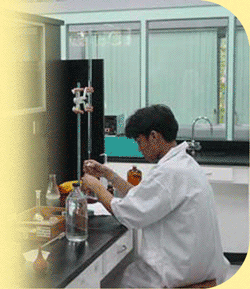| The Department • Projects • News / Events • Contact Us | ||||||
 |
||||||
| Drug
Testing and Monitoring |
||||||
The University of San Carlos Department of Chemistry is equipped with a High Performance Liquid Chromatrograph (HPLC) and a Fourier Transform Infrared (FTIR) Spectorophitometer. HPLC techniques allow us to separate components of
complex mixtures and quantify the parent drug compound and its metabolites
from biological samples. FTIR spectroscopy enables us to detect and
identify functional groups of unknown drug metabolites or validate the
authenticity and purity of pharmacological samples by comparing them
against known standards. |
||||||
|
Chemistry a Tool for
Forensic Science Forensics is a second term generally meaning analytical, as applied to crime scene analysis. Forensic Science is recently popularized by TV shows like CSI & CSI:Miami. Within the broad scope of forensics science is forensic toxicology, which is concerned with the detection and characterization of porous and toxins. Chemical toxicological analysis includes a variety of physical, chemical, spectrophotometric and chromatographic tests used to identify unknown substances. Forensic Toxicology Forensic Chemistry research at University of San Carlos in the Department of Chemistry, undergraduate research studies have been conducted by Tuvilla (BPI Science Awardee 2004) and Vasquez on the influence of ethanol and paracetamol on the detection timeof the drug phentermine. Phentermine is an active component in commom diet pills. Working towards his M.S. Chem. Thesis, Bacolod is developing a method for determining the detection time of phentermine in blood, hair and urine samples using HPLC through a research grant from DOST-PCHRD. |
 |
|||||
|
© Copyright 2004 University of San Carlos. All
rights reserved. |
||||||